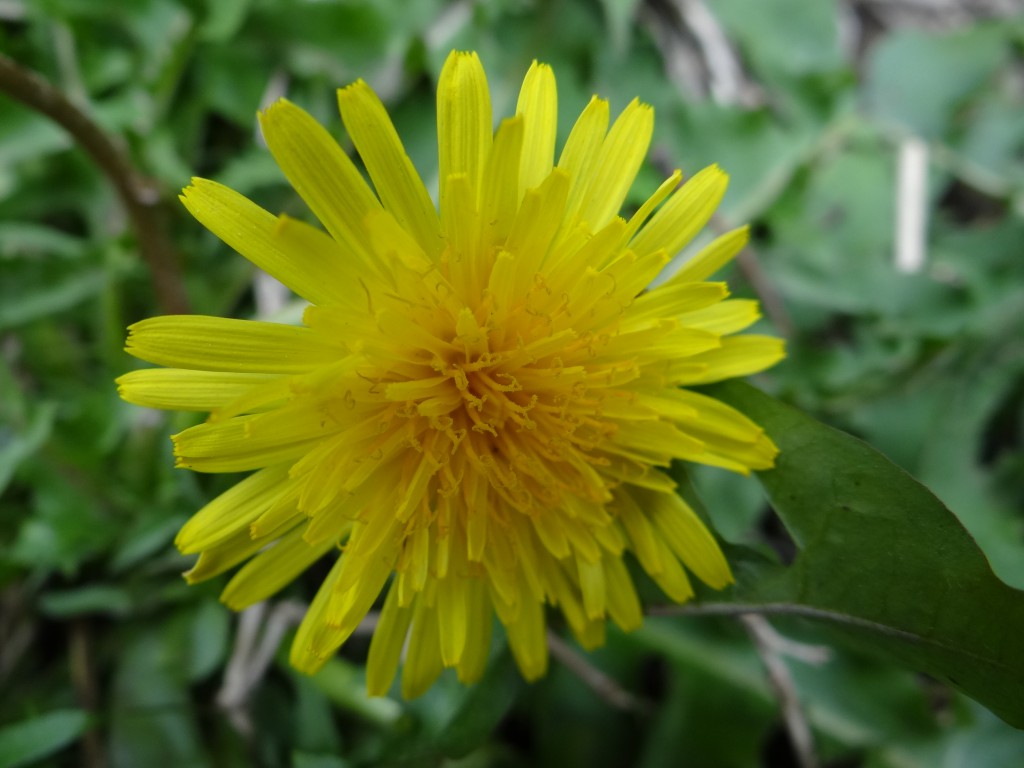While you’re waiting for those succulent morel mushrooms to pop up in size and number, there’s another spring wild edible nearby that you should harvest and eat.
What is it?
Well, it’s growing in your yard.
Any ideas?
It is the dandelion!
No, don’t stop reading the blog, bear with me here, please.
Look, I know that dandelion is the scourge of yards, lots, flower beds, gardens and fields this time of year here in Nebraska. But that scourge – (Taraxacum officinale) – can be picked, washed and made into a terrific, highly nutritious, organic-type salad. Provided, of course, that those dandelions haven’t been treated with harmful chemicals or fertilizers, and there’s no road residue on them, or you haven’t let your pet relieve itself or defecate on them. If you have plant allergies or are taking prescription medications, consult your physician before ingesting the leaves or any other part of the dandelion plant.

With all bases covered, allow me to inform you about dandelions and then, maybe you’ll join me in preparing a simple, but yummy dandelion leaf salad topped off with several dandelion flowers.

If you’re wondering, the dandelion, a member of the daisy family, is a perennial, herbaceous plant. It has long, deeply-toothed, lance-shaped leaves. The plant got its name from the leaves. In the Old French language: Dent-de-lion translates to the tooth of the lion. Dandelion leaves run about 3 to 12″ long, and are roughly 1/2 to 2-1/2″ wide. The grooved leaves funnel rain to the root.


Historically, dandelion roots and leaves were used to treat liver problems. Native Americans also boiled dandelion in water and took it to treat kidney disease, swelling, skin problems, heartburn, and upset stomach. In traditional Chinese medicine (TCM), dandelion has been used to treat stomach problems, appendicitis, and breast problems, such as inflammation or lack of milk flow. In Europe, dandelion was used in remedies for fever, boils, eye problems, diabetes, and diarrhea.
Today, herbalists recommend using the roots to stimulate the appetite, and for liver and gallbladder problems. Dandelion leaves are used as a diuretic to help the body get rid of too much fluid.
From a food perspective, dandelion leaves are used to add flavor to salads, sandwiches, pizzas and teas. The roots are used in some coffee substitutes, and the flowers are used to make wines and garnish salads. These flowers can even be friend up into fritters! The mature flowers add color, texture, and sort of an unusual bittersweet flavor to an array of foods.

The leaves are more nutritious than virtually anything you can buy in the supermarket. According to the University of Maryland Medical Center, dandelions are low in calories, packed with vitamins and nutrients and higher in beta-carotene than carrots. Health experts and researchers there say dandelions are chocked full of vitamins A, B, C, and D, as well as minerals, such as iron, potassium, calcium and zinc. The iron and calcium content is phenomenal, they add, greater than that of spinach. Dandelion greens also come loaded with lutein and zeaxanthin which are two nutrients important for healthy eyesight.
Nutritionally, why not consider using a wild, free, scrumptious-tasting plant that grows on virtually every lawn, right?

It’s best to collect dandelion leaves now, in the springtime, when they’re at their tastiest, before too many flowers appear. You can gather them again in late fall, if desired. After a frost, their extremely tart flavor seems to disappear. Dandelions growing in rich, moist soil, with the broadest leaves should be sought. Pick out the youngest ones, and avoid plants with more than one flower.

There are avid foragers who eat the green leaves also in summer and fall, when they have the potential to be quite bitter. The strong, sharp flavor can be boiled out with a couple changes of water. Dandelion greens are splendid in salads. They can even be sauteed or steamed. I’ve heard a few folks say the leaves of dandelions taste like chicory and endive, with an earthy heartiness coupled with hints of bitterness. Some say the taste of dandelion resembles a slightly bitter green like arugula, a yellowish-flowered Mediterranean herb of the mustard family referred to as the garden rocket that is cultivated for its foliage and used most notably in salads.

The dandelion leaf salad is a fantastic introduction to eating things that grow wild near where you live! It is so scrumptious, you may soon find yourself with a new perspective on what you once considered to be an ongoing, pesky, spring problem in your yard. Below is a that delish dandelion salad recipe that I think you should try.
‘DANDY-LION’ SALAD
Ingredients
– 1/2 pound cut and torn dandelion green leaves
– 1 shallot or 1/2 red onion, chopped
– 2 tomatoes, chopped
– 1/2 teaspoon dried basil
– salt and pepper, if desired
Directions
Wash dandelion leaves and flowers well with water. In a medium bowl, toss together dandelion leaves, shallot or red onion, and tomatoes. Season with basil. Add salt and pepper to taste, if desired. Apply your favorite salad dressing.

Enjoy! I’m not sharing this salad with anyone, HA!

Get more information about spring wild edible plants in Nebraska here.
The post Waiting for Morels? Try Dandelions! appeared first on NEBRASKALand Magazine.

















